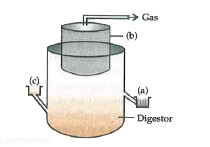Give two reasons for using gobar (cow dung) in biogas plant.
Step-by-Step Solution:
1. Understanding Gobar (Cow Dung):
- Gobar, or cow dung, is a natural waste product from cows. It is rich in organic matter and is often used in various agricultural and energy production processes.
2. Reason 1: Source of Organic Material:
- Cow dung serves as a rich source of organic material. In a biogas plant, organic materials are essential for the anaerobic digestion process, where microorganisms break down the organic matter in the absence of oxygen to produce biogas. The high organic content in cow dung makes it an ideal substrate for this process.
3. Reason 2: Availability and Cost-Effectiveness:
- Cow dung is readily available in rural areas where livestock farming is common. It is often considered a waste product, making it a cost-effective option for biogas production. Using locally available resources reduces transportation costs and makes the biogas plant economically viable.
Final Answer:
1. Cow dung is a rich source of organic material necessary for the anaerobic digestion process in biogas plants.
2. It is readily available and cost-effective, making it an ideal choice for biogas production.
- Gobar, or cow dung, is a natural waste product from cows. It is rich in organic matter and is often used in various agricultural and energy production processes.
- Cow dung serves as a rich source of organic material. In a biogas plant, organic materials are essential for the anaerobic digestion process, where microorganisms break down the organic matter in the absence of oxygen to produce biogas. The high organic content in cow dung makes it an ideal substrate for this process.
- Cow dung is readily available in rural areas where livestock farming is common. It is often considered a waste product, making it a cost-effective option for biogas production. Using locally available resources reduces transportation costs and makes the biogas plant economically viable.
1. Cow dung is a rich source of organic material necessary for the anaerobic digestion process in biogas plants.
2. It is readily available and cost-effective, making it an ideal choice for biogas production.
Topper's Solved these Questions
Similar Questions
Knowledge Check
Read the following statements regarding methanogens and select the correct option.
(i) They are included in the group Archaebacteria.
(ii) They are responsible for the production of biogas in gobar gas plants.
(iii) They live in hot sulphur springs.
(iv) They are strictly anaerobic.AStatement(i) and (ii) are correct.BStatements (i),(ii) and (iv) are correctCStatements (ii),(iii) and (iv) are correct.DAll statements are correct.Read the following statements regarding methanogens and select the correct option.
(i) They are included in the group Archaebacteria.
(ii) They are responsible for the production of biogas in gobar gas plants.
(iii) They live in hot sulphur springs.
(iv) They are strictly anaerobic.AStatements (i) and (ii) are correctBStatements (i),(ii) and (iv) are correctCStatements (ii),( iii) and (iv) are correctDAll Statements are correctThe fungi growing on cow dung belongs to,
AzygomycetesBasidiomycetesCQomycetesDAscomycetes
The diagram above is that of a typical biogas plant. Explain the sequence of events occurring in a biogas plant. Identify a, b and c.

View SolutionThe diagram below is that of a typical biogas plant. Explain the sequence of events occurring in a biogas plant. Identify a,band c.

View SolutionWhich one produce gas by decomposing the gobar (Dung) in gobar gas
View SolutionOne of the following is not a required in the formation of biogas in a biogas plant. This is :
View SolutionBacteria utilised in gobar gas plants are
View Solution
